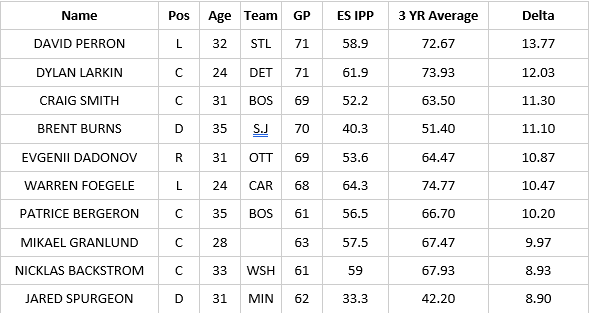With the NHL start date of January 13th announced let's turn our attention to projections. Obviously, make sure you pick up the Dobber Guide, but if you want to do some of your own there are a few stats that might help in that journey. For the next few articles, we are going to take a look at stats from 2019-20 and try and figure out what they can tell us about a player's performance and what they might mean for 2021.
This week: Even Strength IPP
A player's IPP, or Individual Point Percentage, is the number of goals that a player got a point on that were scored when he was on the ice. So, an IPP of 75 percent means that in he got a point on three of every four goals that were scored while on the ice.
How is this number useful? Well in general players fall into predictable ranges. These ranges are defined by their role and their own personal history. For example, elite top-line players can have an IPP consistently in the 75-80 percent range. Connor McDavid is pretty consistently around 80 percent while Sidney Crosby is usually around 75 percent. Less elite players, or players with more well-rounded, slightly more responsible games might have a slightly lower IPP. Jonathan Toews and Bo Horvat are typically between 65 and 70 percent. Power-play defensemen might be a bit lower still. Guys like Kris Letang, and Shea Weber usually hover around the 45-50 percent range, while a strong even strength string defensemen like Charlie MacAvoy might be closer to 35-40 percent.
If we look at a player's personal history and have a general idea of some of the ranges of sustainable IPP, and we see a change over a short period of time it is a clue that either something has changed in their game (usually deployment), or that their current scoring pace is likely unsustainable.
For today we are going to focus on even-strength IPP. Five-on-five play is by far the largest sample size we can look at, and most players score the majority of their points at even strength. It serves as a good baseline for a player's performance. Power-Play IPP is also important, particularly for elite players who score a lot of points on the power play, and the same rules apply as described above.
To get started today we are going to use the Advanced Stats report from Frozen Tools. The report gives a IPP in several states (total, even strength, and power play), points-per-60, five-on-five shooting percentage etc. and we will get to some of them later in this series.
Looking at one year's worth of data is only marginally helpful. If you have a really good grasp on a player's personal tendencies or expectations based on their role scanning through the list might flag some players whose numbers look off, but to really get into it we need additional years of data to establish a baseline. To do that I pulled three seasons' worth of player data and combined them into a three-year average. We can then compare a player's 2019-20 performance to their personal average to see who had the most consistent or inconsistent performance.
The table below shows the players who had the largest growth in the even strength IPP in 2019-20. I added a couple of filters to games played and point totals to ensure that we were mostly looking at fantasy relevant players.
In this chart the negative changes mean they performed higher than average – which could be a flag for future regression and lower production.

Our filters are a bit of a blunt instrument as we can see on the top of this list. Guys like Martin Necas and Andrew Mangiapane rank very highly (which is not a good thing) but if we take a look at their careers, we see they have few seasons and games played to their credit, which makes it more likely these numbers are off. Necas, for example, technically has games played in three seasons, but only seven games played in 17-18 and one in 16-17. That means his 2019-20 numbers aren't really a fair comparison – he hasn't established a baseline yet.
Tony DeAngelo is also very high on this list, almost seven percentage points higher than Frank Vatrano, the next highest ranked player. DeAngelo is also young but does have a few actual seasons to his name. In his case it is worth taking a look at his jump a bit more. In order for us to think the big change might be sustainable we would want to see something change for DeAngelo. Something did in the offseason – he moved to the Rangers and was a fantasy darling mostly because of his performance on the power-play. Taking out those points we do still see a rise at even strength (as indicated might be the case by his even-strength IPP). His total time on ice didn't shift that much, but his shooting did. He jumped to a shooting percentage over 10 percent which is very high for DeAngelo, and for defensemen in general. Playing with the Rangers has clearly agreed with him, but it does look like his even strength performance might be a little too strong.
So what kind of scale are we talking about here? There seem to be a lot of players around the 10 percent mark (and if you were to look at the full list it continues for another 10-12 players), but what does that translate to in point production?
Let's look at Crosby as an example. He scored 47 points in 41 games for a 94-point pace. 30 of those points came at even strength (a 60-point full season pace). He pointed on 88 percent of the goals scored while he was on the ice, so got a point on 30 of 34 possible points. If he had pointed on 78 percent of the goals instead he would have had a 53 point full season pace (a loss of seven points), which would have dropped him to an 87 point pace overall.
On the flip side we have a number of players who performed well below their average.

Highest on this list is David Perron. We might interpret that to mean he is the most likely to improve upon his 2019-20 even strength performance if all other factors were to stay the same. What is really interesting about this is that Perron actually had a very solid year. He put up essentially a 70-point pace over 71 games. His power-play numbers (pace and IPP) were a little higher than usual so that might regress a bit, and his personal shooting percentage was a little bit high, but the implication here is that he could be in for a better even strength performance to make up for those loses. Of course, being 32 could start to make that harder at some point, but there is definitely some reason to like his 2019-20 performance.
Much of the rest of this list, Dylan Larkin, Brent Burns etc. definitely saw less-than-satisfactory years. And seeing them ranked highly on this list does give us some hope on them bouncing back. As with all of the players we have looked at though, there are other stats to check out to get a full picture of a player and we will be checking in on them in the next few articles.
That is all for this week. Thanks for reading.
Stay safe out there.
Want more tool talk? Check out these recent Frozen Tool Forensics Posts.





 FLA
FLA CHI
CHI NYR
NYR PIT
PIT L.A
L.A COL
COL CAR
CAR UTA
UTA SEA
SEA
 NYI
NYI TOR
TOR N.J
N.J WSH
WSH
